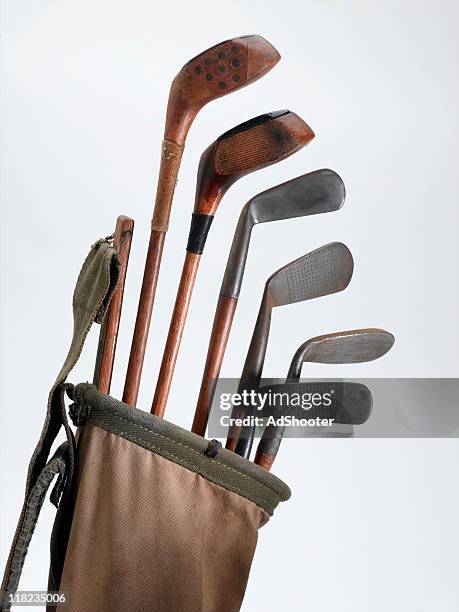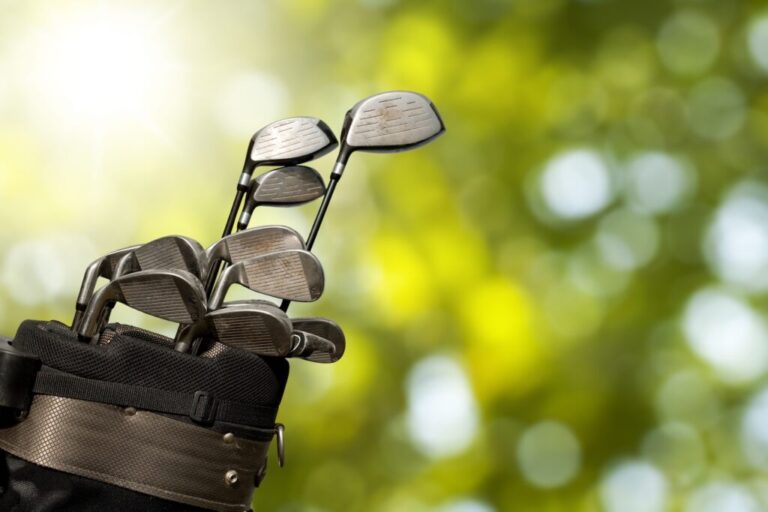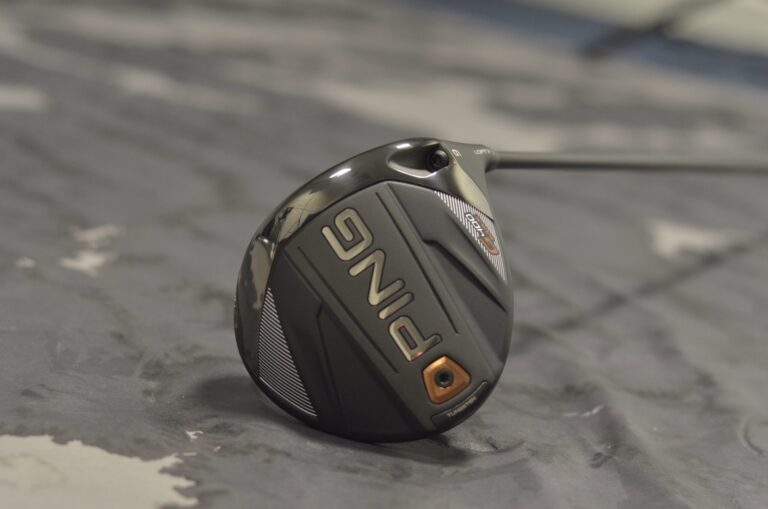Golf is a sport rich in history. Vintage or antique golf clubs hold a special charm.
Golfers and collectors alike cherish these old clubs. They offer a glimpse into the past. Each club tells a unique story, reflecting the craftsmanship of its era. Owning a piece of golf history can be thrilling. Imagine playing a round with the same type of club used by legends.
The feel, weight, and design differ from modern clubs. This creates a unique playing experience. Whether you seek to enhance your game or start a collection, vintage golf clubs are fascinating. Let’s explore the allure of these timeless treasures. Discover their value, history, and appeal. Dive into the world of vintage golf clubs and uncover their hidden gems.

Introduction To Vintage Golf Clubs
Discover the charm of vintage golf clubs. These antique pieces tell stories of the sport’s history. Collectors and players treasure them for their unique designs and craftsmanship.
Vintage golf clubs hold a unique charm. They tell stories of the past. Collectors and golf enthusiasts value them highly. These clubs are not just tools but pieces of history. They show how the game has evolved over the years. Let’s dive into what makes them special.
Definition And Characteristics
Vintage golf clubs date back to the early 20th century. They are often handcrafted. Made from materials like wood and iron. The craftsmanship is detailed and precise. Many have unique designs and markings. These features make each club distinct. Modern clubs are mass-produced. Vintage ones offer a glimpse into the past.
Why Collect Vintage Golf Clubs?
Collecting vintage golf clubs can be a rewarding hobby. They add charm to any collection. Displaying them can spark conversations. They also have historical value. Some collectors see them as investments. Their value can increase over time. For golf lovers, they offer a connection to the game’s roots. “`
History Of Golf Clubs
The history of golf clubs dates back centuries. The evolution of these essential tools reveals much about the game of golf. Golf clubs have undergone significant changes in design and materials over the years. This journey is fascinating and provides insight into the sport’s development.
Early Designs And Materials
Early golf clubs were simple. They were often made from wood. The shafts were typically fashioned from ash or hazel. The clubheads were usually made from tougher woods like beech or apple. These materials were chosen for their durability and availability.
In the early days, each club was handcrafted. This meant no two clubs were exactly the same. Players had to adjust their techniques to each unique club. This added a level of skill and adaptability to the game. The early designs were rudimentary but effective for the time.
Evolution Over The Decades
Over the decades, golf clubs evolved significantly. In the 19th century, metal clubheads began to emerge. These were initially made from materials like iron. This shift allowed for more precise and durable clubs. Players could achieve greater accuracy and distance with metal heads.
By the 20th century, steel shafts became popular. These replaced the traditional wooden shafts. Steel shafts were more consistent and longer-lasting. This change improved the overall performance and reliability of golf clubs.
Today, modern golf clubs use advanced materials. Graphite and titanium are common in the latest designs. These materials offer a perfect balance of strength and weight. They have revolutionized the game, making it more accessible and enjoyable for players of all levels.
Types Of Vintage Golf Clubs
Vintage golf clubs are treasures for collectors and golf enthusiasts. These clubs hold historical significance and showcase the evolution of golf technology. Understanding the different types of vintage golf clubs is essential for any collector.
Woods
Woods are among the oldest types of golf clubs. They were traditionally made from persimmon or hickory. These clubs are known for their long-distance capabilities. Classic wood clubs often have unique designs and craftsmanship.
- Persimmon Woods: Popular in the early 20th century.
- Hickory Woods: Used in the late 19th and early 20th centuries.
- Brassie: A type of wood used for longer shots.
Irons
Irons are versatile clubs used for various shots. Vintage irons often feature forged steel heads and hickory shafts. These clubs offer a glimpse into the craftsmanship of the past.
- Niblick: An early type of wedge.
- Mashie: Similar to a modern 5-iron.
- Jigger: Used for approach shots.
Putters
Putters are essential for the final strokes on the green. Vintage putters come in various designs, reflecting the creativity of their makers. They often have distinctive styles and materials.
- Blade Putters: Simple and elegant design.
- Mallet Putters: Offer more stability.
- Wooden Putters: Rare and collectible.
Unique And Rare Types
Some vintage golf clubs are unique due to their limited production or unusual designs. These clubs are highly sought after by collectors.
| Type | Description |
|---|---|
| Long Nose Woods | Early wooden clubs with long, thin heads. |
| Transitional Irons | Irons from the switch from hickory to steel shafts. |
| Square Toe Putters | Putters with a distinctive square head shape. |
Collecting vintage golf clubs is a rewarding hobby. Each club tells a story of the game’s rich history.
Identifying Authentic Vintage Clubs
Identifying authentic vintage golf clubs requires a keen eye and detailed knowledge. Collectors and enthusiasts value these clubs for their historical significance and craftsmanship. Knowing what to look for is key to finding genuine pieces.
Brand And Maker Marks
Brand and maker marks are crucial identifiers on vintage clubs. Look for engraved or stamped names on the club head or shaft. Well-known brands include Spalding, MacGregor, and Wilson. These marks often show the name of the manufacturer and sometimes the model. They are usually found on the back of the club head or near the grip on the shaft.
Material And Craftsmanship
The materials used in vintage clubs differ from modern ones. Early clubs were made from hickory wood shafts and persimmon wood heads. Steel shafts became popular in the 1930s. Authentic vintage clubs have unique craftsmanship. Hand-forged iron heads and hand-wrapped grips are common features. These details highlight the care and skill of the original makers.
Evaluating The Condition
Evaluating the condition of vintage or antique golf clubs is crucial for collectors and enthusiasts. Understanding the state of these clubs helps determine their value and usability. Two key aspects to consider are signs of wear and tear, and the choice between restoration and maintaining original condition.
Signs Of Wear And Tear
Examine the clubhead first. Look for rust, dents, or scratches. These signs can affect the club’s performance and value. Check the shaft for cracks or warping. Wooden shafts are more prone to damage. Metal shafts can also show signs of bending or corrosion.
Grips are another important area. Original leather grips may be worn or cracked. Replacement grips can decrease the club’s value. Pay attention to the overall feel of the club. It should be firm and solid, not loose or wobbly.
Restoration Vs. Original Condition
Deciding between restoration and keeping the club in its original condition can be challenging. Restored clubs can look almost new. But, they may lose historical value. Collectors often prefer clubs with original features, even if they show signs of age.
Restoration can include re-gripping, cleaning, or repainting. These actions can improve the club’s appearance and usability. But, they might reduce its authenticity. Weigh the benefits of a pristine look against the value of originality.
Consult with experts if unsure. They can provide guidance on the best approach. Remember, each club is unique. What works for one may not work for another. Happy collecting!

Valuing Vintage Golf Clubs
Valuing vintage golf clubs can be a fascinating journey. Many factors influence the worth of these relics. Knowing what affects their value helps both collectors and sellers.
Factors Affecting Value
The condition of the golf club greatly impacts its value. Clubs in mint condition fetch higher prices. Age is another crucial factor. Older clubs are often more valuable.
Brand and model also play a significant role. Renowned manufacturers like Spalding or Wilson often have higher value. Rarity adds another layer. Limited-edition clubs or those with unique features are more prized.
Historical significance can elevate a club’s worth. Clubs once owned by famous players or used in significant tournaments are highly sought after. The material used in the club’s construction matters too. Wooden clubs, especially those made from hickory, are often more valuable.
Popular Valuation Guides
Several guides can help determine the value of vintage golf clubs. The “Kovels’ Antiques & Collectibles Price Guide” is a reliable resource. It provides up-to-date pricing information.
“The Antique Golf Club Price Guide” is another valuable tool. It offers insights into pricing trends and rare finds. The “Collector’s Encyclopedia of Golf Clubs” is also worth consulting. It covers various models and their respective values.
Online forums and communities can be helpful too. Sites like GolfWRX have dedicated sections for vintage clubs. Engaging with other collectors can provide real-time market insights. Always cross-check information from multiple sources for accuracy.
Where To Find Vintage Golf Clubs
For golf enthusiasts, finding vintage or antique golf clubs can be a rewarding experience. These clubs not only hold historical value but also bring a unique charm to any collection. But where can you find these prized items? Let’s explore some popular avenues.
Auctions And Estate Sales
Auctions are excellent places to find vintage golf clubs. Many auction houses specialize in antique sports equipment. They often have a range of clubs from different eras. You can attend in person or bid online.
Estate sales also provide a treasure trove of options. Families often sell collections of old sports gear, including golf clubs. Arrive early to get the best picks. Check local listings for estate sales in your area.
Online Marketplaces And Forums
Online marketplaces offer a convenient way to find vintage golf clubs. Websites like eBay have a wide selection. You can search by brand, era, or condition. Always read seller reviews and product descriptions carefully.
Forums dedicated to golf enthusiasts are another valuable resource. Members often trade, sell, or give advice on where to find rare clubs. Join these forums to connect with like-minded collectors. They can offer tips and leads on where to find what you are looking for.

Caring For Your Collection
Owning a collection of vintage or antique golf clubs is a hobby that combines passion and history. Ensuring these clubs remain in pristine condition is essential for both their value and your enjoyment. Proper care involves knowing how to store, clean, and maintain your collection. Let’s explore some tips for each aspect.
Proper Storage Techniques
Proper storage is crucial for preserving your golf clubs. Here are some tips:
- Keep clubs in a dry place. Moisture can damage the wood and metal.
- Avoid direct sunlight. UV rays can fade and weaken the materials.
- Use club covers. They protect the heads from dust and scratches.
- Store in an upright position. This prevents warping of the shafts.
Cleaning And Maintenance Tips
Regular cleaning and maintenance are key to keeping your clubs looking their best.
- Wipe clubs after each use. Use a soft cloth to remove dirt and grime.
- Clean the heads monthly. Use a mixture of mild soap and water.
- Dry thoroughly. Ensure no moisture remains on the clubs.
- Check for rust. Remove rust with a fine steel wool and oil.
- Polish the wood. Use a quality wood polish to maintain shine.
By following these tips, you can enjoy your vintage golf clubs for years to come.
Building A Network
Building a network is essential for any vintage or antique golf club enthusiast. Connecting with like-minded people can provide valuable insights and opportunities. You can learn more about the history, value, and maintenance of your collection. Here are some ways to build your network in the vintage golf club community.
Joining Collector Communities
Join online forums and social media groups dedicated to vintage golf clubs. These platforms are a treasure trove of information. You can ask questions, share experiences, and learn from seasoned collectors. Facebook and Reddit have active groups where members discuss everything about antique golf clubs. Staying active in these communities can help you stay updated on trends and market values.
Attending Golf Club Shows
Attending golf club shows is another great way to expand your network. These events gather enthusiasts, collectors, and sellers. You can meet face-to-face with people who share your passion. Shows often feature lectures, exhibitions, and sales. These events provide a hands-on experience with antique golf clubs. You can also discover rare finds and learn proper restoration techniques. Networking at these shows can lead to lasting friendships and valuable contacts.
Legal And Ethical Considerations
Collecting vintage or antique golf clubs can be a rewarding hobby. Yet, it’s crucial to understand the legal and ethical aspects involved. This ensures that you respect laws and maintain integrity.
Import/export Regulations
When collecting, be aware of import and export laws. Each country has its own rules. Violating these can lead to fines or confiscation of items.
Some vintage golf clubs may contain materials like ivory or exotic woods. These are often regulated under international law. Check the CITES list before purchasing or selling such items.
A table of common materials and their regulations can be helpful:
| Material | Regulation |
|---|---|
| Ivory | CITES |
| Exotic Woods | Local Laws |
| Animal Parts | Wildlife Protection Acts |
Ethical Collecting Practices
Ethical collecting involves respecting the historical and cultural value of items. Avoid purchasing stolen or looted goods. Verify the provenance of each piece.
Support reputable dealers and auctions. They often provide documentation and authenticity certificates. This ensures your collection remains legitimate.
When selling, be transparent about the item’s condition and history. Honesty builds trust within the collector community.
Follow these ethical practices:
- Research the item’s history.
- Verify authenticity with experts.
- Avoid illegal or dubious sources.
- Document each purchase and sale.
By adhering to these guidelines, you contribute to a responsible and respected collector community.
Frequently Asked Questions
What Are Vintage Golf Clubs?
Vintage golf clubs are older models, typically from the early 20th century. They are often made of wood or iron. Collectors and enthusiasts seek them for their historical value.
How To Identify Antique Golf Clubs?
Identify antique golf clubs by their materials, design, and manufacturer marks. Look for wooden shafts and leather grips. Research the club’s history for accurate identification.
Are Vintage Golf Clubs Worth Money?
Yes, vintage golf clubs can be valuable. Their worth depends on rarity, condition, and historical significance. Some clubs can fetch high prices at auctions.
Where To Buy Vintage Golf Clubs?
You can buy vintage golf clubs at antique shops, online marketplaces, and specialty golf stores. Auctions and estate sales are also good sources.
Conclusion
Exploring vintage or antique golf clubs can be a rewarding hobby. These clubs carry history and unique craftsmanship. Collecting them can connect you with golf’s rich past. They also make great conversation pieces. Take your time to learn about different types.
Enjoy the journey of discovery. Happy collecting!




